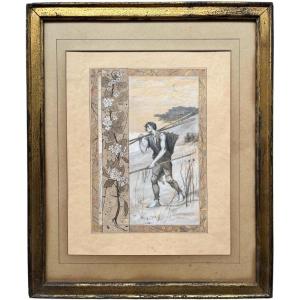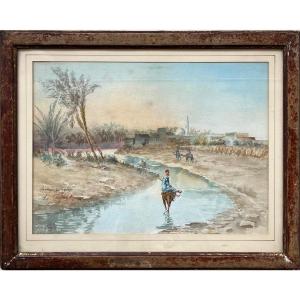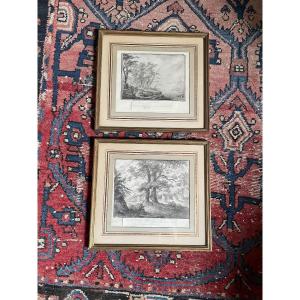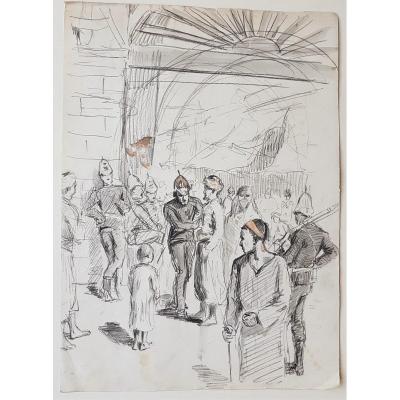(Paris 1848 - 1912)
Caricatures
22nd December 1896
Graphite pencil and black ink on paper with the Bilan de l'exercice financier 1895-96 de la société des artistes français (balance sheet for the 1895-96 financial year of the society of French artists)
27.5 x 42.5 cm
annotated by the collector ‘Detaille 22 décembre 96’ lower left
a small tear at the top of the balance sheet, folds
Provenance: Georges Lemaire collection, by descent
Find out more :
Édouard Detaille was an academic artist and illustrator, a pupil of Ernest Meissonier, best known for his military scenes. Renowned for his historical realism and eye for detail, he was particularly famous for his work on uniforms, and was asked by the Ministry of War to design certain outfits.
He was also deeply involved in the artistic life of his time, taking an active part in the Salons de peinture, was elected a member of the Académie des Beaux-Arts in 1892 and chaired the Société des Artistes Français from 1896 to 1900.
Two of our drawings were made on the balance sheet of the Société des artistes français, published in autumn 1896 for the period 1895-1896, at the very beginning of Édouard Detaille's presidency.
The document is a sheet folded in two, forming four pages.
On the cover, a sketched caricature shows the face of a cleric, most likely Pope Leo XIII (1810-1878-1903), then in office. The head is round; the caricatured features include a wide mouth with pursed lips, an aquiline nose and strongly arched eyebrows. The headdress is slightly fanciful, a cross between a mitre and a papal tiara, decorated with motifs but unclear in shape.
Inside, in the fold of the document, is a more detailed drawing of a figure with intriguing attributes. A caricature of a man with bushy eyebrows, unshaven cheeks, vague eyes and a small pipe in his mouth, he too appears to be dressed in the white, gloved robes of a pope. His hands are clasped, as if in a pious gesture, which contrasts with the neglected appearance and posture of his face, but above all with the headdress, the most curious feature of the portrait. It looks like a bonnet covering the ears, rising to the top of the head and topped with a small tuft of hair, echoing the man's thick eyebrows. In some respects, it is similar to the Phrygian cap, and recalls the shape of certain infantry helmets, a reminder of Detaille's passion for the military imagery of his century.
The overall impression is zany, grotesque, fanciful in certain elements - particularly the headdress - and deliberately incoherent on the whole. It is likely that Detaille wanted to depict a man who was not a soldier.
A few words about the Georges Lemaire collection (Bailly 1853 - 1914 Paris):
A member of the Société des artistes français from 1887, Georges Lemaire soon became a member of the jury.He attended many of the sessions, and his presence is attested to, among other things, by the numerous reports in which he appears alongside the greatest artists of his time.
He soon set about methodically collecting the sketches and sheets of paper left by his colleagues at the end of these sessions.Between 1892 and 1913, he compiled them in his personal collection.
These sheets clearly reflect the artists' urgency to create, produce and represent what they were observing, or perhaps their need to escape during the long sessions they attended.
A collection that is plural in terms of the number of artists it features, it also has several common denominators that help to make it utterly unique. Firstly, there is the temporal and spatial context of production: these drawings were all produced in the context of the meetings of the Société des artistes français. There is also the medium, as most of the sheets collected by Lemaire are of the same workmanship: medium-quality paper, most likely distributed at the beginning of the session. The artists sometimes used other printed materials, such as menus, agendas or the society's financial statements.
The drawings in this collection are extremely varied: small sketches, caricatures, attempts to revive style, sometimes close to automatic writing...
Some of the drawings are signed by the artists themselves, while the others are listed thanks to the collector, who took care to note the names of the artists whose sheets he collected.





































 Le Magazine de PROANTIC
Le Magazine de PROANTIC TRÉSORS Magazine
TRÉSORS Magazine Rivista Artiquariato
Rivista Artiquariato